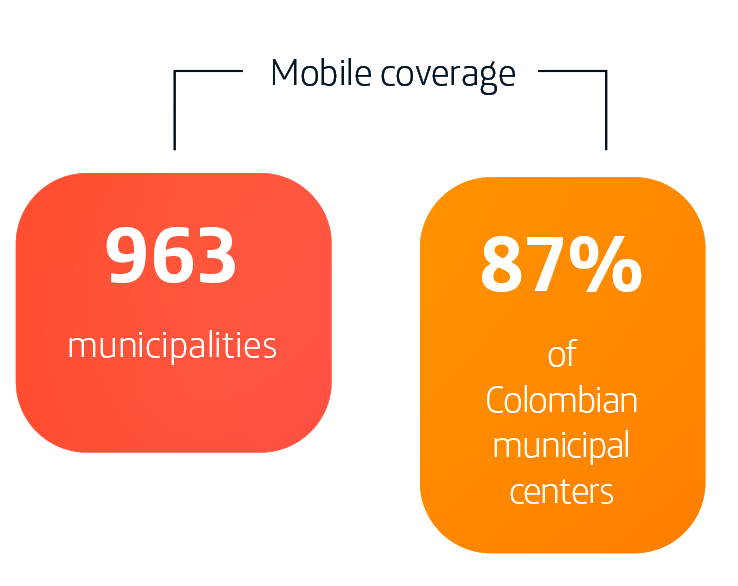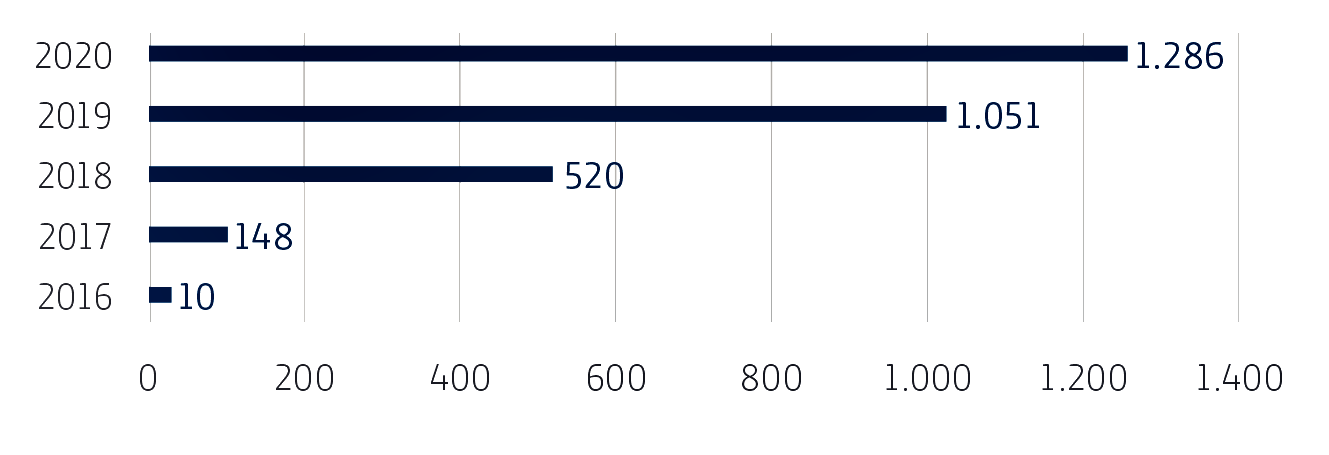Responsible Management Report 2020
7.4.2. We reconnect by bringing the benefits of digitalization to everyone
E
S
G

Digital growth and infrastructure rollout
Telefónica Movistar’s goal is to provide the best quality connectivity possible to its almost 20 million Colombian customers and to all its future users in any place and from any device, so that they can discover a world of endless possibilities.
In recent years, Movistar Colombia has focused its efforts on expanding the development of 4G mobile coverage and the rollout of fiber optics, because one of the ways it has contributed to the country’s digital growth is through the creation of economic value and investment in infrastructure, which enables it to reach all regions of Colombia and guarantee connectivity.
Since its arrival in Colombia in 2006, the Company has invested around COP 15.2 trillion in infrastructure. For this to be good quality connectivity that really facilitates the country’s productive activity, it has invested in efficient and
high-quality technologies. Therefore, in 2020, 50% of the investment in infrastructure was based on LTE and fiber optic connectivity, which has enabled it to offer its customers higher speeds, a greater variety of services and more affordable prices. In total, 963 municipalities have mobile coverage (87% of Colombian municipal centers), 425 municipalities have 4G LTE, and we ended 2020 with around 1.3 million homes having access to fiber-optic connection.
In 2020, to offer excellent connectivity and contribute to the Sustainable Development Goals (SDGs), Telefónica Movistar Colombia invested more than COP 654,412 million in the rollout. This investment consists of infrastructure development to support mobile and fixed-line communications, as well as strengthening the customer service platforms, special connectivity projects, such as the National Training
425
municipalities have 4G LTE
1,3
MM
homes having access to fiber-optic connection.
Service’s (SENA, for the Spanish original) project, and fiber optics.
Thanks to this connectivity, in 2020, people could remain connected to their jobs, education and their loved ones. This is now an essential element to build fair, inclusive and sustainable societies, because digital lives are now real life. Therefore, we are committed to not leaving any one behind.
In 2020, 50% of the investment in infrastructure was based on LTE and fiber optic connectivity, which has enabled it to offer its customers higher speeds, a greater variety of services and more affordable prices.
Network rollout
and investment
Fiber optics
HOMES CONNECTED WITH FIBER OPTICS
(In thousands)

1
Symmetrical speeds up to 300 MB:
As the first and only operator on the market to offer the same upload and download speeds, we maintained speeds of up to 300 MB, enhancing the experience for customers who demanded more and better connectivity for the use of applications for work, education, entertainment and communication.
2
IPTV
The Company continued with the fiber-optic TV offer, increasing the ultra-high speed connection through the latest generation audiovisual content platform.
3
Partnership with Netflix and Amazon Prime
Entertainment platforms included in the postpay plans and fiber-optic internet plans from 150 MB, and 10 MB internet (Netflix), and Full Home Triple Fiber (Amazon Prime).
4
WiFi signal booster – BasePor
Makes it possible to enjoy the best WiFi experience in all devices from any part of the home.
5
Unlimited national calls.
6
International long-distance calls
(200 minutes).
7
Movistar Total
This offer, designed to generate greater benefits for convergent customers, has the IlimiDatos plan and speeds from 150 MB with tariffs starting at COP 199,900 and additional benefits, such as: higher speed, more LDI minutes (500 LDI minutes from a landline and 500 from a cellphone), a McAfee license for three devices, and Netflix included.
193
expansions
of carriers
33
municipal capitals intervened in order to expand the LTE footprint
4G rollout
More localities with LTE: : In digital access, one of the most important events of the previous year was the investment in infrastructure, which enabled an increase in coverage of 4G LTE technology, reaching 425 municipal centers, as well as improving existing technology through the rollout of 193 expansions of carriers that enable an increase in the mobile network.
More spectrum for 4G LTE: Refarming activities were carried out, i.e., the review and amendment of the rights and conditions of use regarding a spectrum frequency bandwidth with the aim to expand the LTE footprint, starting intervention in the 10 main cities and their metropolitan areas (a total of 33 municipal centers) with a large rollout, helping to expand the capacity of the 4G network and, consequently, improving the coverage and user experience.
IoT
Wayra IoT (Internet of Things) Laboratory in which all the IoT tests were completed. It keeps operating in the three LTE bandwidths with LTE-M and NB-IoT.
Some special projects underway stand out:
LTE-M
LTE-M was rolledout for 478 Huawei cells in Bogotá, Ibagué and Neiva.
5G
Pilot 5G project in the Bogotá Secretary of Health:The first pilot 5G project was launched in Colombia in May 2020, with the main purpose of assuring the connectivity of a thermal imaging camera that can report when a person exceeds a body temperature of 37.3°C, showing a warning in an app that can be installed in a cellphone or PC. The images and alerts can be monitored in real time. More than 4,000 people have been tested with this camera. Remote monitoring is currently being continued.
Network uptime
and quality indicators
For network operation, 2020 was also a challenging year due to the high levels of traffic in residential areas and the mandatory isolation measures and mobility restrictions in some sectors. However, average levels of service uptime higher than 99.94% were maintained throughout the network. For services, the uptime indicator was 99.97% in basic lines and 99.94% in broadband and FTTH. Similarly, the mobile access network obtained an average indicator of 99.92%, measured with the parameters of current regulation.
99.97%
basic online availability indicator
99.94%
broadband availability indicator
Average levels of service uptime higher than 99.94% were maintained throughout the network.

In terms of the network quality indicators, during 2020, as well as the bandwidths adjusted to ensure traffic as a result of the hyper-connectivity during the pandemic, the Company successfully launched the ilimiDatos plan, which generated a growth peak in data consumption and in the fixed network. However, the Company continued to meet the quality parameters required by the regulators.
Business continuity management
Telefónica Movistar’s Business Continuity Management System in Colombia has level 5 “Enhanced” within the maturity model defined by Global Operations Security Management. This level represents the Company’s commitment to developing a culture of resilience, which is necessary to continue
the provision of critical services, gaining the trust of customers and stakeholders in general if events occur that interrupt the normal provision of services.
The year 2020 was one of resilience in which the contingency strategies established by the Company played
a leading role when supporting the continuity and recovery processes. The COVID-19 pandemic marked a landmark due to the massive implementation of the remote working strategy, which put the Company’s business continuity to the test in an unexpected crisis that had an impact on humanity.
Hurricane Iota, which affected the Archipelago of San Andrés, Providencia and Santa Catalina, was another high-impact risk incident that materialized during 2020. This incident affected the provision of services in the archipelago and demonstrated the Company’s capacity for recovery in adverse events. The different groups’ teamwork and the implementation of contingency and recovery strategies were essential to become the first operator to resume service in the archipelago, which will be described in more detail in the following section.
Continuous improvement has been an essential pillar in the Business Continuity Management System, and during 2020, emphasis was made on strengthening contingency strategies in the Company’s critical processes, as well as increasing the scope of monitoring the continuity and contingency models of suppliers categorized as critical, with the aim to comprehensively strengthen the system’s strategies.
Success story:
Internet recovery in the Archipelago of San Andrés and Providencia after Hurricane Iota
Telefónica Movistar’s process to be the first operator to ensure communications in the Archipelago of San Andrés, Providencia and Santa Catalina started two days after the arrival of the hurricane. Warned by the increase in level of the natural phenomenon, which in just a few hours, increased from category 2 to category 5 (the rating with the highest destructive force) in the Saffir-Simpson Scale, Movistar implemented a preventive plan to protect infrastructure on the islands, as well as the availability of equipment and expert people on the continent prepared to travel immediately and respond to the emergency.
Being the Company with the greatest coverage in San Andrés and Providencia, Movistar reported that the damage to the communications infrastructure was considerable. Out of 25 radio antenna
98%
Recovery level in San Andrés
at the end of 2020
97%
Recovery level in Providencia
at the end of 2020
3,000
SIM cards recharged with minutes and data delivered free of charge to the affected population
bases installed in San Andrés, ten were broken down due to the hurricane, while in Providencia, only one of the Company’s five towers was left standing
So, the damages were verified and assessed once in the field. Given the scale of the impact on infrastructure and the need of the area’s inhabitants to communicate during this crisis, especially in Providencia, we had to activate the engagement protocol with external entities. Thanks to the support of the Colombian Government, the Navy, the local authorities and the National Unit for Disaster Risk Management, Movistar managed to transport human resources and technical equipment to roll out the plan to sustain and recover communications.
As a result of the extraordinary effort, Movistar’s work team achieved the recovery of 83% of the mobile service and 95% of the fixed service in the Island of San Andrés in less than 48 hours. At the end of 2020, the level of recovery in San Andrés was 98%.
Similarly, the service recovery process in Providencia was in record time, because the recovery of the antenna located on Buenavista Hill in Providencia was prioritized. This is the antenna that has the greatest coverage for providing the service in the island’s area with the highest population density, as well as being the one with a radio connection to San Andrés. The staff of Movistar and its partners started to rebuild using items that they managed to recover despite the damage and humidity, as well as the spare parts transported from Cartagena and Bogotá via San Andrés. Consequently, Movistar was the first operator to recover mobile services in Providencia on November
The work plan for San Andrés and Providencia not only included the normalization of mobile services on the archipelago, but also a significant technology upgrade: 60% of the 2G network that was available in San Andrés is being fully replaced with 4G, which means that Movistar will increase from having four stations on the island with this technology to 14 in 2020. Additionally, to support the data and call traffic that this upgrade involves, since December 7, 2020, the capacity of the submarine cable EIA was increased, almost doubling it in terms of interconnection in transmission. This plan is expected to be completed in the first quarter of 2021.
60% of the 2G network that was available in San Andrés is being fully replaced with 4G, which means that Movistar will increase from having four stations on the island with this technology to 14 in 2020.
22, 2020. At the end of 2020, the level of recovery in Providencia was 97%.
This technical work was accompanied by humanitarian and support actions, not only for the affected population, to which 3,000 free SIM cards with minutes and data were given out, but also supporting the work of the Mayor’s Office of Providencia and the National Unit of Disaster Risk Management, through the delivery of mobile equipment and another 1,030 SIM cards with minutes and data for the team in the field.
More digitalization to facilitate the users’ experience
The year 2020 was one of consolidation and maturity of the Company’s digital transformation plan, which during the lockdown measures, enabled us to make digital solutions available to customers for self-management of the main transactions through channels such as the web, the application and WhatsApp®, with high levels of service and great uptake.
TIER III Certification
Aiming to have the best infrastructure as support and a lever to meet the business requirements, in January 2020, we launched the Orion Data Center, and in September, this project received the TIER III Design certification, reflecting the successful work of all the team members.
This accreditation is granted by the Uptime Institute, an independent division of The 451 Group, which is comprised of notable members of the IT infrastructure industry, specialized consultants and international users of the services, who endorsed the design documents. This guarantees that the site’s infrastructure topology meets appropriate criteria for energy, cooling, maintenance and capacity to support any failure in operations.
Movistar continued with the lines of work of the Reconecta-#Returns plan in areas including service, sales, technical support, payments and top ups, which enabled us to keep customers at the center, achieve improvements in processes, capture efficiency, and achieve recurring and incremental savings, and tangible benefits throughout the value chain, such as:
Adoption of digital
transactions:
93.7%
of billing is digita (+4p.p.)
42.7%
of our customers use digital media to make their payments
21.2%
of total sales are made through
the digital channel
Positioning
of the web as the main sales channel o terminals
+50%
of upgrades/replacements are executed by the Phoenix robot
Thirty-one solutions available for customer self-management in different channels:
25
transactions available for self-management in WhatsApp
24
available on the web and in the application
6
through less conventional digital channels, such as IVR and USSD
Improvement of the automation processes
WhatsApp®, second main service channel
Telefónica Movistar Colombia is the first operator in the country and in the Telefónica Group to implement service through an official WhatsApp® account (+57 3152333333) to collectively resolve the requirements of our prepay, postpay, fixed line and convergent customers, thanks to integrated artificial intelligence and human support, achieving milestones, such as:
11.1
Million sessions
86%
resolved
28%
of interactions were handled by a WhatsApp advisor
7x24
availability for inquiries and transactions - The channel includes technical support and sales transactions
To protect customers and service advisors during the lockdown months, all of the channel’s technical infrastructure was strengthened to be able to attend to more than one million transactions a month with more than 400 advisors working from home. This represents a 50% increase in service since the launch of the channel in 2019, which led to 40% of service being attended remotely in the Company, with 80% of self-service by BOT, improved by all the implemented developments that facilitate customer experience in the channel in critical processes including consulting bills and balance, self-management and self-remedy in technical support for fixed and mobile products, payment agreements, and digital payments.
Full stack management
The final phase of home products of the Greta project was rolled out in 2020 as part of the migration of B2C and SME customers to the new customer management system. The “sunset” of the project was also developed, which implemented the respective closure, transitioning more than 100 people to the respective business areas, as well as the delivery of new processes, added to the Company’s change to the new “Agile” work model.
With this, Telefónica Movistar became the first operator on the Colombian market to have a fully convergent value proposition (100% convergent service channels, offers, billing, provisioning, and business processes). As well as the
final migration, a successful stabilization process was developed with the commitment and support of all of the Company’s departments, especially with the necessary leadership and traction from the business, starting and ending with the customer.
Automation of
payment processes
The installation of self-payment machines was started in 2020 in 87 experience centers to enhance customer service, reducing the service time for this obligation and generating savings in work stations and bank commission. Additionally, during the year, billing management was carried out online through the IRIS management solution and collection

robots, reducing work stations by 50% and improving the recovery rates.
Automation of complaint, grievance and request management
Although the Company has regulated service channels to attend to all complaints, grievances and requests, actions were developed to improve customer experience through digital and self-management channels focused on solving the most recurring issues for users.
During the last quarter of 2020, an option was created for the customers who wish to register a complaint, grievance or request, access, and receive a solution online without having to wait the regulatory 15 business days for a solution. We have attended more than 40,000 customers through said channel.
Agile Solutions button:
With the inclusion of this button on the website, designed to receive and process customer requests in less than three days, we have managed to solve more than 90,000 requests through this web channel. In 2020, thanks to the implementation of the Sustainable Value Creation initiative, the Agile Solutions button was integrated into the Mi Movistar.
ATIS, the main challenge in the shutdown of applications
One of the main challenges and achievements of 2020 was the permanent shutdown of ATIS (CRM of the fixed-line business). With ATIS, another 35 applications were shut down, which generated operating efficiency, facilitating the migration activities between the data center and architecture management, and simplifying the control points for the management of events, incidents and problems.
CTS self-management
During 2020, the self-management project achieved 69% coverage in technical support interactions. One of the main achievements was the implementation of the mobile reconciliation services in the chat bot, resolving 83% of the sessions and preventing transfer to an advisor. Self-management processes were implemented in the home segment for copper as well as fiber optics, becoming the first channel (chat bot) to provide customers with the self-management option for fiber optics. Similarly, seven service flows were successfully implemented in the WhatsApp® channel.
Toolbox
In 2020, this project enabled the reduction of the amount of calls/chats that the customer service line agents receive, facilitating their self-management. This achieved a 38% reduction in the service line events, exceeding the proposed target of 37%.
DevOps for integration
In 2020, Movistar achieved the implementation of the DevOps project, a work model based on the automation of processes and responsibilities that seeks the integration of development and operations as a single team. This model facilitates and makes the work more effective, improves the quality of the services, reduces the delivery times of the solutions, improves the interaction between the IT departments, enables greater frequency of delivery to production, minimizes the possible errors and requirement of extra effort, and generates more decentralized architectures and much more homogeneous processes.
1
Decrease in rollout lead time
Enables the delivery of products to our customers in the shortest time possible and with the best quality (decrease from seven to three days).
2
Design of a new model to create a rollout pipeline, decreasing from 93 days to 35 days, reducing times by 63%.
3
Design of a generic pipeline for the OSB that will enable the automatic rollout of an average of nine services per month with an 80% gain in execution times.
69%
coverage of self-management project in technical service interactions
83%
sessions solved in the chatbot
AIOps, artificial intelligence
for IT operations
During 2020, in AIOps, Telefónica Movistar managed to self-remedy 61% of the incidents generated in operations. Additionally, it started production of 156 new automation features, it shut down 1,132 jobs that were attended to in the computer center and it automated 49 automatic deployments with UrbanCode Deploy.
CTS remedy
Through the “Customer Technical Support Self-Remedy” project, work has been carried out to change from a network-based operations management model to a customer-oriented mechanism, which has the capacity to understand, manage and ensure the user experience, resolving any problem before it is perceived through automations, in order to achieve greater operating efficiency and digital transformation. In 2020, we achieved: (i) a 20% reduction in support failures reported to the call center; (ii) that 97% of the supported clients did not need to contact the call center again; and (iii) an average of five million transactions a month with 81% effectiveness.
The ilimiDatos offer marked a milestone in the market and established Movistar as an innovative company, by incorporating differentiating products and services.
IlimiDatos
With the aim to strengthen its commitment to its customers and the country, in 2020, Movistar made the best offers available to its customers so that they could remain connected for telework and study, and enjoy different entertainment options. Therefore, in June, it launched new truly unlimited data plans called, Ilimidatos from a monthly fee of COP 75,990 including VAT, being the only operator on the Colombian market with a plan like this in prepay and postpay in 2020. It is the first truly unlimited plan for the Colombian market.
The Ilimidatos offer marked a milestone in the market and established Movistar as an innovative company, by incorporating products and services that set it apart from the competition, such as Netflix, which added to those it already offered, such as data roaming and internet data sharing, and to date, are still exclusive to Movistar.
Digital products and services
As well as the automation processes, Movistar maintained its commitment to develop a portfolio of digital products and services for its B2C and B2B customers. The following products and services in this portfolio stand out:
20%
Reduction of support failures reported to the call center
97%
Of remediated customers did not generate a call back to the call center
5
million average transactions per month
Big Data
As part of this solution, the Company develops advanced analytical capacity that has enabled the integration of machine learning techniques, such as text analytics, geo analytics and neural networks in the descriptive, predictive and prescriptive models that improve the Company’s customer management. Additionally, 14 of these models operate on the Real Time Decision platform.
In a year in which digitalization accelerated as a result of COVID-19, the use of big data was one of the main solutions offered by the Company. During 2020, the first big deal of Smart Steps (of the LUCA Transit segment) was developed, a product based on information from mobile cells, applied in the project by the Ministry of Housing.
As a result of this work, LUCA Colombia, the Data and Artificial Intelligence Unit of the Telefónica Group, was the leader in Hispanic America with the increase in revenues during 2020. During the year, the Company obtained a 234% growth in big data Y/Y and managed to make 12,174,791 transactions during 2020 in LUCA ATP, with 165% growth from 2019.
Additionally, it is worth mentioning that Movistar won the first two places in #DataJam of the CRC with innovative proposals in access to information and communication technologies (ICT) and mobile portability, which were proposed by the Company’s employees.
Big data for social good
En Movistar el uso de los datos también está al servicio de la sociedad, contribuyendo de manera significativa con la Agenda 2030 y el cumplimiento de los Objetivos de Desarrollo Sostenible.In Movistar, the use of data is also at society’s service, significantly contributing to the 2030 Agenda and the achievement of the Sustainable Development Goals
Aware of the contribution of data to understanding and responding to social emergencies, in 2020, the Company participated in the COVI D -19 Epidemiological Intelligence System (SISCOVID, for the Spanish original) in partnership with entities such as the Universidad de los Andes, and which had the goal to study the dynamics of the virus through mathematical and computer simulation models supported by mobility data (including MNO data) and surveys to provide evidence for decision-making in five cities of the country: Barranquilla, Bogotá, Cali, Cartagena and Medellín.

Additionally, with the LUCA and the International Center for Strategic Thinking (CEPEI, for the Spanish original), an analysis case was published to understand the internal and external advocacy process during and after the landslide that occurred in the city of Mocoa (Putumayo) in March 2017. These data are available on the platform: www.datarepublica.org.
234%
Growth of bigdata A / A
12,174,791
Transactions during
2020 at LUCA AT

Smart Agro: sustainable, responsible and innovative agriculture
Movistar is fully committed to helping to achieve the 2030 Agenda. Aware of the contribution of technology to the development of sustainable agriculture, in 2018, it started the Smart Agro project together with the United Nations Food and Agriculture Organization (FAO). The project’s goal was to improve the irrigation process and the control of chemicals in crops through the Internet of Things and data analytics, in order to make the agricultural processes more effective and to provide greater benefits to farmers. After two years of implementation and the development of three pilot projects in Boyacá,
Santander and Nariño, the partnership with the FAO was completed.
The results obtained in the production cycle of the second pilot project (Tablón de Gómez, Nariño) demonstrated an increase of more than 400 kg per hectare in production, compared to a traditionally farmed crop, which assumed an increase of 40% in yield to between 63% and 67%. In turn, in the case of the first and
The project’s goal was to improve the irrigation process and the control of chemicals in crops through the Internet of Things and data analytics, in order to make the agricultural processes more effective and to provide greater benefits to farmers.
second pilot projects, a profit was generated for 25% of the producers.
Internet of Things (IoT)
For the sixth year in a row, the Company was acknowledged as the leader in the Gartner Magic Quadrant for Managed Internet of Things (IoT) Connectivity Services, Worldwide. The above was due to Movistar working continuously through vertical IoT to be at the cutting edge of the customers’ needs and to offer the
most innovative solutions of the market. In 2020, the Company kept working to activate IoT networks for narrowband and LTE-M on its mobile network, increasing its footprint in primary cities including Bogotá, Medellín and Cali.
Similarly, Movistar contributed to the management of digital transformation in education through connectivity, energy efficiency or Smart Agro projects, among others, generating an outstanding income for the segment. The Company also accompanied the banking sector with IoT solutions, generating benefits for customers and contributing to digital transformation.
Additionally, Movistar and Wayra celebrated the first anniversary of the Internet of Things Laboratory –CEmprende Hub for the enterprise launched in 2019– with IoTDay. This online event brought together the Internet of Things industry, in which representatives of the enterprise ecosystem, the
Colombian Government and academia participated with more than 200 attendees at the workshops and the talks of partners, such as Quectel, Hubspot, Universidad del Rosario and Oracle
Cloud
Cloud solutions enable the storage of services in the cloud, as well as the availability of solutions for business self-management, which integrate tools to ensure connectivity, communications or management of work teams, among other items.
In 2020, the Company’s Cloud solutions portfolio had 15 products and services, and one of the benefited sectors was banking, through two projects. The first provided an integration solution for unified communications based on extensions, contact center, recording of calls, pricing, and a transformational governance model. The second provided the design, implementation and operation of UCaaS services.
Thanks to the management of these services, in June 2020, the Company renewed its Gold Membership with Microsoft, it was recertified in ISO 27001 for the data center, and it received four certifications of Microsoft Azure: two in Azure Administrator, one in Azure Architect Technologies and one in Azure Architect Design, and the expansion of the scope of the ISO 9001 quality certification for the data center.
Gracias a la gestión de estos servicios, en junio de 2020 a la Compañía le fue renovada la Gold Membership de Microsoft, fue recertificada en ISO 27001 para el Data Center, recibió las 4 certificaciones de Microsoft Azure: 2 Azure Administrator, Azure Architect Technologies y Azure Architect Design, y la ampliación de los alcances de la certificación de calidad ISO 9001 para el área de Data Center.
Digital security
In a year in which digital security was put to the test, Movistar continued to establish itself as one of the most important companies in digital security services. Thanks to its management of these services, Movistar was recertified in ISO 27001 for its security operations center (SOC) and in Check Point 8 for the Certified Security Administrator R80, and Check Point 4 for Certified Expert
In 2020, the digital security portfolio was significantly increased with
In a year in which digital security was put to the test, Movistar continued to establish itself as one of the most important companies in digital security services.
In 2020, Movistar established its innovation management with a system that aims to build a comprehensive ecosystem starting with its employees.
designed digital products and services in cybersecurity and at the end of the year, the Company had around 20 solutions in this segment.
Innovation Management System
In 2020, Movistar established its innovation management with a system that aims to build a comprehensive ecosystem starting with its employees, through intra-enterprise, and which is reinforced with the participation of academia, public administration, the private sector and trade groups or associations in order to generate synergies that enable the transfer of knowledge, the solution of challenges and the generation of areas that make innovation more dynamic in productive environments.
Under this initiative, partnerships have been strengthened with the CESA, Pontificia Universidad Javeriana, Universidad del Rosario and Universidad Santo Tomás, posing challenges to improve the experience of its customers and challenges to build society through sustainable development.
Other partners that have also been key to strengthening the ecosystem are the ANDI, National Planning Department (DNP, for the Spanish original), the Mayor’s Office of Bogotá and its Secretary of Economic Development, or INNpulsa –through its advocacy programs of the enterprise ecosystem, such as CEmprende and HéroesFest–.
Additionally, private companies also opened their doors to the Company so that technology can facilitate the solution of challenges
for the community’s benefit and the opening of opportunities for discussion to build knowledge.
Thanks to this management, for the first time, Telefónica Movistar entered the Top 10 in the Innovation Ranking organized by the ANDI and Dinero magazine, moving up 14 places from the 2019 ranking and positioning itself as one of the most innovative companies in the country. Additionally, the Global Compact Network Colombia awarded the design of this system as the best practice of the private sector with respect to SDG 11: Sustainable cities and communities, in the Acknowledgment of Best Sustainable Development Practices; and the Innovation Management System was certified by the Bogotá Chamber of Commerce and Icontec with the Seal of Good Innovation Practices for a two-year period. This seal acknowledges that the system is at an advanced level with a score of 98.9 out of 100 and highlights Senior Management’s commitment in the ongoing search and support for disruption.
Intra-enterprise
Aware that the Company’s employees are the best source of innovation, the work in intra-enterprise managed two innovation calls for proposals, which had the main challenges of reducing the churn and new strategies to boost Movistar Business. These calls for proposals produced four feasible projects, which also leverage operation through internal innovation.
Telefonica Movistar entered the Top 10 in the Innovation Ranking organized by the ANDI and Dinero magazine, moving up 14 places from the 2019 ranking and positioning itself as one of the most innovative companies in the country.

Additionally, two virtual hackathons were held. The first had the aim to find ideas that through digitalization will mitigate the impacts of COVID-19 in four areas, specifically: occupational health and safety, technical service, customer experience and sustainability. The second searches for potential ideas to respond to the regulatory sandbox proposed by the MinICT, which involves making regulation more flexible for innovation projects.
Wayra
In 2020, Wayra Colombia, which is part of Wayra Hispam, continued to be one of the main participants and drivers of the ecosystem, aiming to bring open innovation to Movistar through its Corporate Investment Fund model.
Together with the operations of Argentina, Chile, Mexico and Peru, and consolidated with Wayra Hispam, the joint trademark has the essential strategy to pursue the regional impact of each one of the local portfolios and to bring innovation to Movistar that can be replicated and scaled up in the different operations of Hispanic America.
The previous year ended with 25 Wayra companies working together with Telefónica Movistar Colombia, of which 23 generated revenues or savings for it.
The investment strategy focuses on connecting the portfolio of companies that have a direct link with Movistar, both locally (Colombia) and regionally (Hispanic America), such as service providers or suppliers of digital products for operation, or as part of the catalog that the operator offers to its customers.
As a result of the above, Wayra Hispam included eight companies in the portfolio with innovative solutions that are of interest for the different operations of Telefónica Hispanoamérica (Kriptos, Rebus, Vozy, UnDosTres, Vu Security, Sirena, Omnix, and Pampumba), two of which are Colombian (Rebus and Vozy), which are also working with the organization in the country.
Additionally, through local and global vehicles, it invested USD 640,000 in the eight aforementioned enterprises, with the investment in Vozy (USD 60,000) disbursed through the vehicle of Wayra Colombia. Similarly, the investment of third parties in the
regional portfolio exceeded USD 66 million, where 22% of this amount was assigned to two companies of the Colombian portfolio: ADDI (USD 15 million) and TiendAPP (USD 180,000).
Regarding the innovation generated in operation by companies that Wayra has invested in, the previous year ended with 25 Wayra companies working together with Telefónica Movistar Colombia, of which 23 generated revenues or savings for it, whether by improving the portfolio of digital products that Movistar offers to its customers or delivering new IT solutions that help the operator to make its internal processes more efficient. This means a 14% growth from 2019, a year in which the 22 companies of Wayra worked with Telefónica Movistar Colombia.
Companies invested in
Active companies in the portfolio
Direct jobs generated
Historical investment of Wayra
Historical investment of third parties
Sales of active companies last year
58
20
1,124
+ COP $ 9,218 M
+ COP $123,933 M
COP $31,026 M
